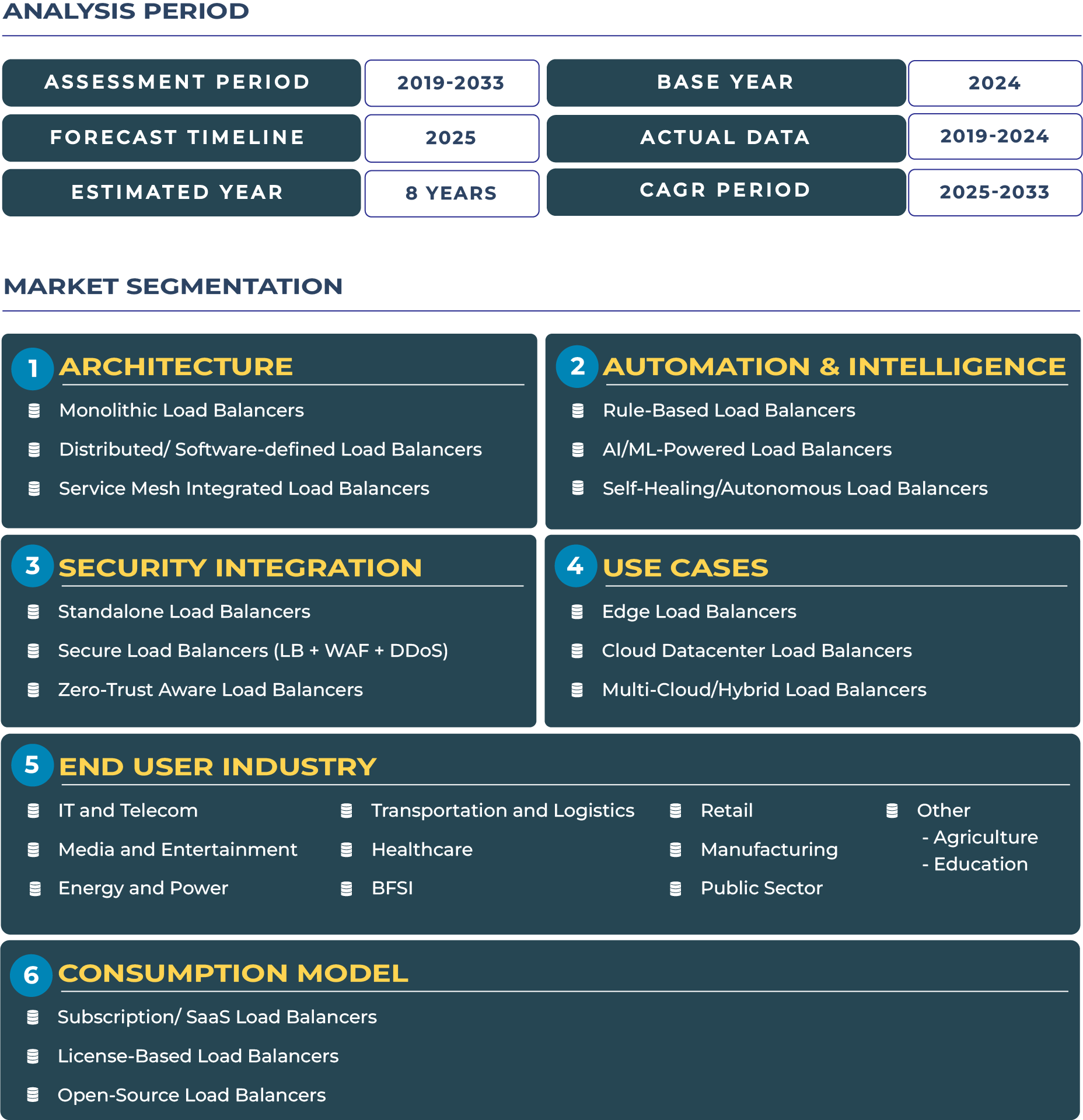Report Format:
![]()
![]() |
Pages: 110+
|
Pages: 110+
Hyper-scale Adoption via Digital Inclusion: India Cloud Load Balancers Market Outlook
India has established itself as the fastest-scaling digital market globally, enabled by strong digital inclusion, government-backed programs, and a thriving startup ecosystem. This inclusive digital landscape has accelerated demand for advanced networking solutions, particularly in the cloud load balancers market. The market, valued at USD 192.7 million in 2025, is projected to expand significantly to USD 546.6 million by 2033, registering a CAGR of 13.9% during 2025–2033. The momentum is largely fueled by affordable scaling strategies promoted by government-led adoption, rapid adoption of cloud by small and mid-sized businesses, and deepening investments by hyperscale providers. India’s supportive ecosystem, reinforced by initiatives under Digital India, creates a strong foundation for cloud-native deployments where load balancing plays a crucial role in ensuring application performance and scalability. Additionally, service mesh integrated load balancers are being widely adopted to address complex multi-cloud architectures, supporting enterprise-grade resilience in sectors such as fintech, healthcare, and OTT services.
Massive Developer Base and Startup Ecosystem: A Key Market Driver
The India cloud load balancers industry benefits from one of the largest developer bases in the world, coupled with a vibrant startup ecosystem. With India hosting more than 100 unicorns and thousands of high-growth startups, the demand for distributed and software-defined load balancers continues to surge. These organizations prioritize agility and cloud-native application development, where seamless load distribution is critical. The rise of fintech players in Bengaluru, OTT platforms in Mumbai, and SaaS innovators in Hyderabad exemplifies this growth. Furthermore, hyperscaler investments, such as the expansion of Microsoft Azure availability zones and local edge nodes by AWS and Google Cloud, have strengthened infrastructure capabilities. These factors position India as a regional hub for innovation-driven adoption, sustaining steady growth across both large enterprises and SMBs.
Price Sensitivity and Infrastructure Gaps: Hindrances to Sustained Growth
Despite its strong momentum, the cloud load balancers sector in India faces challenges that hinder its potential. Price sensitivity remains a critical issue, especially among SMBs in Tier-2 and Tier-3 cities, where IT budgets are constrained. Many organizations delay investments in advanced load balancing due to upfront costs, opting instead for less reliable open-source or on-premise alternatives. Infrastructure gaps such as inconsistent connectivity and latency issues in semi-urban and rural markets also impact adoption. Additionally, there is a shortage of skilled talent specializing in modern service mesh and cloud-native architectures, which can delay enterprise-grade deployment. These challenges highlight the importance of targeted solutions like low-cost SaaS-based load balancers and developer-focused freemium models that align with India’s affordability-driven market dynamics.
Cloud-Native Innovation and 5G Use Cases Driving New Market Trends
The cloud load balancers landscape in India is evolving with clear trends that are reshaping enterprise and SMB adoption strategies. The boom in microservices and containerization has elevated the role of distributed load balancers, enabling efficient management of traffic flows across hybrid and multi-cloud environments. The rollout of 5G and telco-edge deployments, led by operators such as Reliance Jio and Bharti Airtel, are opening new opportunities for edge-based load balancing to support ultra-low latency use cases in gaming, AR/VR, and fintech services. Additionally, the startup-led innovation wave continues to create demand for scalable cloud-native load balancing solutions, especially across OTT platforms and fintech firms managing high concurrency workloads. This alignment of telecom and digital-first businesses is fostering a new era of load balancing adoption in India.
Unlocking Opportunities with Low-Cost SaaS and Developer-Centric Solutions
The India cloud load balancers market is witnessing strong opportunities in SaaS-driven models tailored for SMBs. Affordable, subscription-based load balancer SaaS platforms are enabling smaller businesses to access enterprise-grade scalability without heavy capital expenditure. The rise of developer-centric freemium models further enhances accessibility, creating entry points for startups experimenting with cloud-native architectures. Edge load balancers customized for telcos and OTT providers also present a high-growth opportunity, as these industries seek to ensure smooth traffic handling during peak usage. These opportunities highlight how India’s market can address affordability while unlocking advanced capabilities to serve its digital-first economy.
Strategic Moves Defining the Competitive Landscape
The cloud load balancers ecosystem in India is shaped by the presence of both international hyperscalers and local technology firms. Companies such as F5 Networks, Citrix, and Kemp Technologies compete alongside hyperscalers like AWS, Google Cloud, and Microsoft Azure to deliver scalable load balancing solutions. Local IT service providers are increasingly entering this space, offering tailored deployments for SMBs and enterprises. In 2024, hyperscaler-led investments in distributed and software-defined load balancing frameworks gained momentum as enterprises demanded greater reliability and redundancy. Strategic moves include AWS enhancing its Application Load Balancer to handle AI-driven workloads in India, and Microsoft expanding its load balancing capabilities for Azure Kubernetes Service. These developments highlight an intensifying competition where innovation, pricing, and deployment agility are decisive differentiators in the India cloud load balancers sector.







